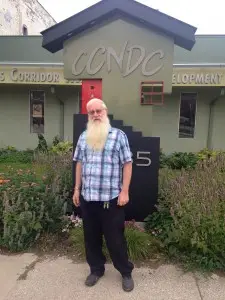
Pat Dorn, Executive Director of the Cass Corridor Neighborhood Development Corporation (CCNDC), describes what his organization does in the following way:
“Our purpose is strictly to provide safe, clean, affordable housing for the residents of the Cass Corridor. We work only in the Cass Corridor. And after we accomplish that mission, then to improve the quality of life of our residents.”
Dorn, who has been active in improving the quality of life for residents of the Cass Corridor for more than 30 years with CCNDC, also happens to be the next-door-neighbor of the El Moore. Not content simply to live in a neighborhood, Dorn’s actions speak louder than any words of his commitment as an architect in the rebuilding and re-imagining of all of Detroit through building and re-imagining this one neighborhood. CCNDC currently operates 27 properties containing 300 rental units.
As someone who has experienced the Cass Corridor/Midtown neighborhood through some of its more dramatic ups and downs during the 45 years he has lived there, Dorn appears hopeful about the current condition of his community, remarking that it is noticeably cleaner and safer (Raised on a farm in Wisconsin, Dorn originally came to Detroit to work with a local church during the Detroit riots/rebellion of 1967). He credits this change at least in large part to CCNDC having what’s known as the ‘first mortgage’ of an apartment building, because banks would never underwrite a mortgage for a property in an area known to be so economically tumultuous and risky.
“We were able to get that first mortgage, which helped a lot of other people to get their mortgages,” which in turn helped to stabilize the neighborhood, which in turn made it safer and cleaner. “It showed that it was a viable option, and then once that started it ballooned.”
When asked to describe how he would characterize his neighborhood right now…?
“I would say it’s Detroit 20 years ahead of time. But I’m old, so maybe it’s only five years ahead of its time. …We just took advantage of what we had in our neighborhood. It’s crazy to think that you can have 5,000 entry level jobs and have no housing in walking distance. There’s nowhere to live. I mean that’s just stupid.”
Expanding the theme even further, Dorn fully expects that what is currently happening in what is now known as Midtown will spread to other neighborhoods throughout the city. But that doesn’t mean – nor should it – that Detroit will become a city full of Midtowns. Far from it. Each neighborhood needs to develop its own assets, to figure out and imagine what a better neighborhood means for its own residents. Not a one-size-fits-all identity but a city full of ever evolving identities, stitched together to create an ever evolving Detroit.
“It’s an exciting time to be alive and to be a part of this, there’s so much new happening. The energy and the strength of the young people moving in is just fantastic.”
Amen.
